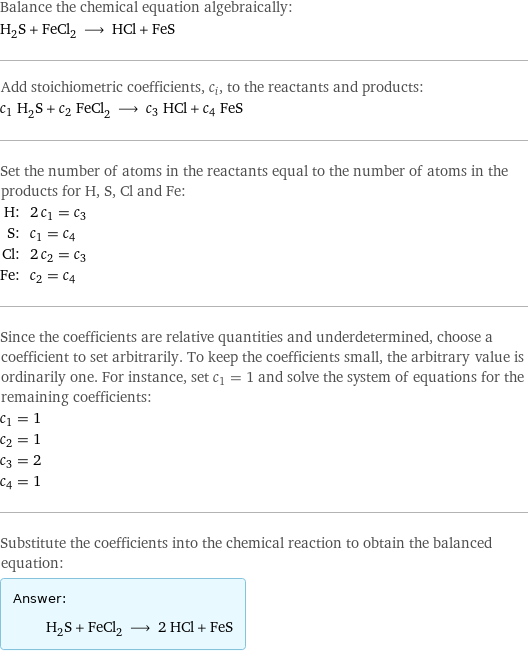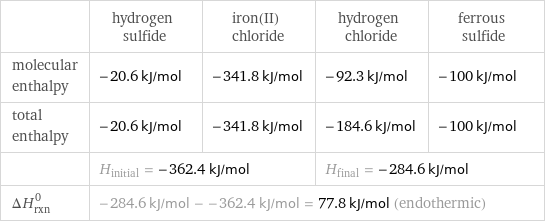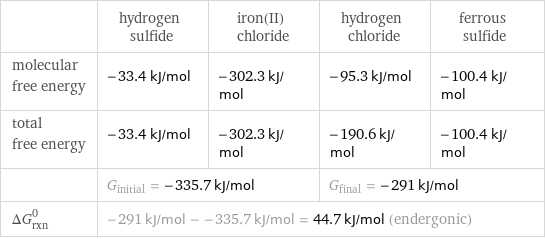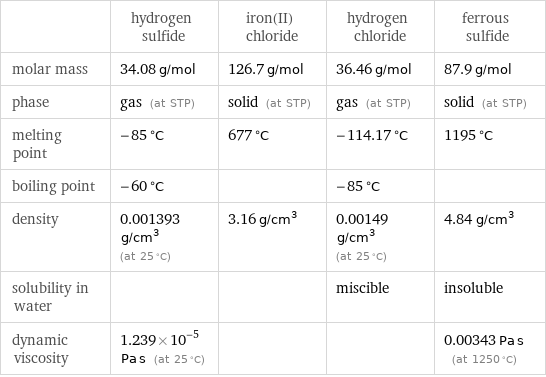Input interpretation

H_2S hydrogen sulfide + FeCl_2 iron(II) chloride ⟶ HCl hydrogen chloride + FeS ferrous sulfide
Balanced equation

Balance the chemical equation algebraically: H_2S + FeCl_2 ⟶ HCl + FeS Add stoichiometric coefficients, c_i, to the reactants and products: c_1 H_2S + c_2 FeCl_2 ⟶ c_3 HCl + c_4 FeS Set the number of atoms in the reactants equal to the number of atoms in the products for H, S, Cl and Fe: H: | 2 c_1 = c_3 S: | c_1 = c_4 Cl: | 2 c_2 = c_3 Fe: | c_2 = c_4 Since the coefficients are relative quantities and underdetermined, choose a coefficient to set arbitrarily. To keep the coefficients small, the arbitrary value is ordinarily one. For instance, set c_1 = 1 and solve the system of equations for the remaining coefficients: c_1 = 1 c_2 = 1 c_3 = 2 c_4 = 1 Substitute the coefficients into the chemical reaction to obtain the balanced equation: Answer: | | H_2S + FeCl_2 ⟶ 2 HCl + FeS
Structures

+ ⟶ +
Names

hydrogen sulfide + iron(II) chloride ⟶ hydrogen chloride + ferrous sulfide
Reaction thermodynamics
Enthalpy

| hydrogen sulfide | iron(II) chloride | hydrogen chloride | ferrous sulfide molecular enthalpy | -20.6 kJ/mol | -341.8 kJ/mol | -92.3 kJ/mol | -100 kJ/mol total enthalpy | -20.6 kJ/mol | -341.8 kJ/mol | -184.6 kJ/mol | -100 kJ/mol | H_initial = -362.4 kJ/mol | | H_final = -284.6 kJ/mol | ΔH_rxn^0 | -284.6 kJ/mol - -362.4 kJ/mol = 77.8 kJ/mol (endothermic) | | |
Gibbs free energy

| hydrogen sulfide | iron(II) chloride | hydrogen chloride | ferrous sulfide molecular free energy | -33.4 kJ/mol | -302.3 kJ/mol | -95.3 kJ/mol | -100.4 kJ/mol total free energy | -33.4 kJ/mol | -302.3 kJ/mol | -190.6 kJ/mol | -100.4 kJ/mol | G_initial = -335.7 kJ/mol | | G_final = -291 kJ/mol | ΔG_rxn^0 | -291 kJ/mol - -335.7 kJ/mol = 44.7 kJ/mol (endergonic) | | |
Equilibrium constant
![Construct the equilibrium constant, K, expression for: H_2S + FeCl_2 ⟶ HCl + FeS Plan: • Balance the chemical equation. • Determine the stoichiometric numbers. • Assemble the activity expression for each chemical species. • Use the activity expressions to build the equilibrium constant expression. Write the balanced chemical equation: H_2S + FeCl_2 ⟶ 2 HCl + FeS Assign stoichiometric numbers, ν_i, using the stoichiometric coefficients, c_i, from the balanced chemical equation in the following manner: ν_i = -c_i for reactants and ν_i = c_i for products: chemical species | c_i | ν_i H_2S | 1 | -1 FeCl_2 | 1 | -1 HCl | 2 | 2 FeS | 1 | 1 Assemble the activity expressions accounting for the state of matter and ν_i: chemical species | c_i | ν_i | activity expression H_2S | 1 | -1 | ([H2S])^(-1) FeCl_2 | 1 | -1 | ([FeCl2])^(-1) HCl | 2 | 2 | ([HCl])^2 FeS | 1 | 1 | [FeS] The equilibrium constant symbol in the concentration basis is: K_c Mulitply the activity expressions to arrive at the K_c expression: Answer: | | K_c = ([H2S])^(-1) ([FeCl2])^(-1) ([HCl])^2 [FeS] = (([HCl])^2 [FeS])/([H2S] [FeCl2])](../image_source/5d45f19bd64076384efde46f08db8c9e.png)
Construct the equilibrium constant, K, expression for: H_2S + FeCl_2 ⟶ HCl + FeS Plan: • Balance the chemical equation. • Determine the stoichiometric numbers. • Assemble the activity expression for each chemical species. • Use the activity expressions to build the equilibrium constant expression. Write the balanced chemical equation: H_2S + FeCl_2 ⟶ 2 HCl + FeS Assign stoichiometric numbers, ν_i, using the stoichiometric coefficients, c_i, from the balanced chemical equation in the following manner: ν_i = -c_i for reactants and ν_i = c_i for products: chemical species | c_i | ν_i H_2S | 1 | -1 FeCl_2 | 1 | -1 HCl | 2 | 2 FeS | 1 | 1 Assemble the activity expressions accounting for the state of matter and ν_i: chemical species | c_i | ν_i | activity expression H_2S | 1 | -1 | ([H2S])^(-1) FeCl_2 | 1 | -1 | ([FeCl2])^(-1) HCl | 2 | 2 | ([HCl])^2 FeS | 1 | 1 | [FeS] The equilibrium constant symbol in the concentration basis is: K_c Mulitply the activity expressions to arrive at the K_c expression: Answer: | | K_c = ([H2S])^(-1) ([FeCl2])^(-1) ([HCl])^2 [FeS] = (([HCl])^2 [FeS])/([H2S] [FeCl2])
Rate of reaction
![Construct the rate of reaction expression for: H_2S + FeCl_2 ⟶ HCl + FeS Plan: • Balance the chemical equation. • Determine the stoichiometric numbers. • Assemble the rate term for each chemical species. • Write the rate of reaction expression. Write the balanced chemical equation: H_2S + FeCl_2 ⟶ 2 HCl + FeS Assign stoichiometric numbers, ν_i, using the stoichiometric coefficients, c_i, from the balanced chemical equation in the following manner: ν_i = -c_i for reactants and ν_i = c_i for products: chemical species | c_i | ν_i H_2S | 1 | -1 FeCl_2 | 1 | -1 HCl | 2 | 2 FeS | 1 | 1 The rate term for each chemical species, B_i, is 1/ν_i(Δ[B_i])/(Δt) where [B_i] is the amount concentration and t is time: chemical species | c_i | ν_i | rate term H_2S | 1 | -1 | -(Δ[H2S])/(Δt) FeCl_2 | 1 | -1 | -(Δ[FeCl2])/(Δt) HCl | 2 | 2 | 1/2 (Δ[HCl])/(Δt) FeS | 1 | 1 | (Δ[FeS])/(Δt) (for infinitesimal rate of change, replace Δ with d) Set the rate terms equal to each other to arrive at the rate expression: Answer: | | rate = -(Δ[H2S])/(Δt) = -(Δ[FeCl2])/(Δt) = 1/2 (Δ[HCl])/(Δt) = (Δ[FeS])/(Δt) (assuming constant volume and no accumulation of intermediates or side products)](../image_source/c868ad04c2714ef04163d437d3534e20.png)
Construct the rate of reaction expression for: H_2S + FeCl_2 ⟶ HCl + FeS Plan: • Balance the chemical equation. • Determine the stoichiometric numbers. • Assemble the rate term for each chemical species. • Write the rate of reaction expression. Write the balanced chemical equation: H_2S + FeCl_2 ⟶ 2 HCl + FeS Assign stoichiometric numbers, ν_i, using the stoichiometric coefficients, c_i, from the balanced chemical equation in the following manner: ν_i = -c_i for reactants and ν_i = c_i for products: chemical species | c_i | ν_i H_2S | 1 | -1 FeCl_2 | 1 | -1 HCl | 2 | 2 FeS | 1 | 1 The rate term for each chemical species, B_i, is 1/ν_i(Δ[B_i])/(Δt) where [B_i] is the amount concentration and t is time: chemical species | c_i | ν_i | rate term H_2S | 1 | -1 | -(Δ[H2S])/(Δt) FeCl_2 | 1 | -1 | -(Δ[FeCl2])/(Δt) HCl | 2 | 2 | 1/2 (Δ[HCl])/(Δt) FeS | 1 | 1 | (Δ[FeS])/(Δt) (for infinitesimal rate of change, replace Δ with d) Set the rate terms equal to each other to arrive at the rate expression: Answer: | | rate = -(Δ[H2S])/(Δt) = -(Δ[FeCl2])/(Δt) = 1/2 (Δ[HCl])/(Δt) = (Δ[FeS])/(Δt) (assuming constant volume and no accumulation of intermediates or side products)
Chemical names and formulas

| hydrogen sulfide | iron(II) chloride | hydrogen chloride | ferrous sulfide formula | H_2S | FeCl_2 | HCl | FeS Hill formula | H_2S | Cl_2Fe | ClH | FeS name | hydrogen sulfide | iron(II) chloride | hydrogen chloride | ferrous sulfide IUPAC name | hydrogen sulfide | dichloroiron | hydrogen chloride |
Substance properties

| hydrogen sulfide | iron(II) chloride | hydrogen chloride | ferrous sulfide molar mass | 34.08 g/mol | 126.7 g/mol | 36.46 g/mol | 87.9 g/mol phase | gas (at STP) | solid (at STP) | gas (at STP) | solid (at STP) melting point | -85 °C | 677 °C | -114.17 °C | 1195 °C boiling point | -60 °C | | -85 °C | density | 0.001393 g/cm^3 (at 25 °C) | 3.16 g/cm^3 | 0.00149 g/cm^3 (at 25 °C) | 4.84 g/cm^3 solubility in water | | | miscible | insoluble dynamic viscosity | 1.239×10^-5 Pa s (at 25 °C) | | | 0.00343 Pa s (at 1250 °C)
Units
